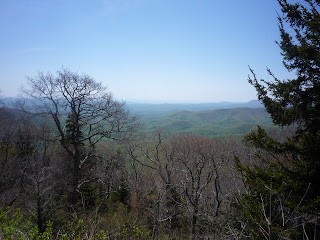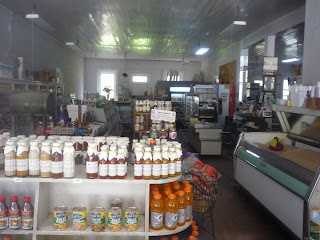.
One of the best places to see some great scenery and have an enjoyable ride in the mountains is not too far from home here in Easley South Carolina. In fact, it is only about 51 miles from home.
And, there is no commercial traffic on this road whatsoever.
By now you probably know I am talking about the
Blue Ridge Parkway. You can look up
all of the details of this 469 mile-long road, but it is, surprisingly, not only a good place to go for an extended adventure, but also for a part-day jaunt of only a few hours.
A couple of weekends ago, I went out on Saturday and took the following route:
View Larger Map
All together, I was out only five hours, but it was a pleasurable time of looking at the scenery, traveling winding roads, and meeting interesting people.
One thing you will note on the map is that I used twisty roads to get to the Parkway, but used mostly divided highways and other main roads to get back home. The idea is that I can enjoy the more challenging roads when I am freshest, and the less technical roads later on. Do any of you readers do this as well?
OK. Lets review the route in detail. I start out on US-178 in Pickens, SC, and follow it to the intersection of SC-11 (Pushpin "B" on the map), where the
Holly Springs Country Store is located. That is the most popular place around here for bikers to meet, plan rides, and brag -- er, talk -- with one another. There are about ten bikes there, but I don't recognize any of them, so I move on, staying on 178 all the way to Rosman North Carolina (at Pushpin "C").
This last section is very popular with bikers, sightseers, and law enforcement officers alike. If you need some excuses for riding this section, here are a few links, with plenty of other information there about places to ride and to visit:
The day is beautiful and just the right temperature in the mountains -- about 65 degrees -- and the humidity is still low -- not dripping like it will be in the summer. The sky is clear and beautiful, with just some wispy clouds here and there.
I gas up at the station in Rosman, and head north. The Parkway is only eighteen miles from here on NC-215. They have recently paved this road, so it is quite smooth. There are scatterings of gravel left over from winter, but I am fooled by something else on the pavement that looks like gravel, but isn't. The white spots spoofing gravel are petals off the flowering trees. That is better than gravel any day. I am told, however, that every time they mow the berms, they scatter the clippings but also the gravel back over the road again, so watch out.
I stop at a gravel pull-off just south of the Parkway entrance, and meet another biker. He disappears into the brush for a while. I suspect that I know what he is doing over there, so I also have a discrete go while he is gone. He reappears, and I introduce myself. It turns out that his name is Steve, an information technology guru from Dallas, working as a consultant to the Marine Corps.
Now, Dallas is about 950 miles from the place I have met Steve, so he has some real miles under his belt. He is combining work with a vacation: He has ridden his bike up here on his way to the
Marine Corps Base Quantico in Virginia. His
entire trip there will be about 1450 miles one way. I note that he is also a
Patriot Guard Rider.
Once he finishes his work near D.C., his wife will be flying in to join him, and they will ride back home via. the Tail of the Dragon and some other good motorcycle roads. I envy the opportunity he has to get away for a while.
I tail him leaving the pull off, then tag along on the Parkway for a spell, and finally pass by him stopped at one of the overlooks. He waves farewell. I hope he has a good trip.
On the Parkway, one must still watch for some hazards. One of them is the tendency to use excessive speed, since the road is limited access, and has no commercial traffic. Tempting as it is, that would be inadvisable, and the fines here are in the $300 range.
You also have to be careful of motorhomes, pedestrians, gawkers, slow-moving vehicles, bicycles, animals, and tunnels. It is easy to come upon one of these with too little warning and get into trouble quickly. The tunnels can be wet (and icy in the cooler season), bicycle riders may be inside, and it is difficult to see well at first entry.
There are, in fact, two ways to enjoy this road -- and you can switch from one to the other instantly!
The first way is to ride just for the sake of riding a reasonably easy, well-maintained road with some twists amongst the turns. The second way is to poke along, stopping often to take in the view at every opportunity.
Today, I am doing more of the first way than the second, so I don't have many pictures to show you. The traffic is not heavy, except in a few places, so I can go along at the speed limit without too much trouble.
This is a view of US-276 taken from an overlook just south of that entrance to the Parkway. The Parkway is the road at the top center. Route 276 snakes down the mountain.
US-276 is also a good way to get back home. The section just south of the Parkway is twisty, then there is a long, unchallenging ride until you get near Caesars Head where the twistiness starts again with a vengeance.
Here you can see a map showing this alternate route.
View Larger Map
I find that the landslide that had prevented my passage going north last year when I went to the
Rally to Ridgecrest has been fixed. The Parkway was closed then just before I reached milepost 405, so I had to take
NC-151 off the Parkway. The first part of that road is known as the "
Devil's Drop", a technical and very challenging road that has about a 7% downgrade and many tight curves. It is located north of Pushpin "D" on this map of that ride.
View Larger Map
Remember that you can explore the map by holding your mouse button down and moving it about. You can also see a larger version with routing instructions if you click on the "View Larger Map" link.
Today, I motor along pretty much without long stops. Just as I come to the place I am going to leave the Parkway, I stop at the overlook of the
French Broad River.
According to Wikipedia
: "The French Broad River was named by white settlers centuries ago because it was one of the two broad rivers in western North Carolina. The one which flowed into land claimed by France at that time was named the 'French Broad River', whereas the other, which stayed in land claimed by England – the Colony of North Carolina – was named the 'English Broad River', later renamed simply to the 'Broad River'."
There is a good view of the Parkway bridge over the river, and there is a somewhat limited view of the river itself. There I dismount for a swig of Gatorade and spot a delivery truck. Now, commercial vehicles are not allowed on the Parkway, so I am curious why it is here. I come closer and note that it belongs to the Williams Piano Service of Whitesville North Carolina. Since I am interested in pianos, and own several player pianos, I strike up a conversation with Danny Williams, the driver. I tell him about my pianos, and he says that as a matter of fact, the piano he has in his truck here is a player piano that he will be restoring for a customer. We talk [piano] shop for a few minutes. (It is surprising how long a conversation can be when the topic is one you are interested in.) Danny says that he is about to leave the Parkway, so I don't say anything about his truck being here.
I finish my drink, and continue. I exit the Parkway, and turn south, eventually reaching an entrance to I-26 and US-25. These are quick ways to get there, but not very interesting. I find a rest area along the way and stop to wolf down a couple of snack bars. This little guy seems very interested in a snack. I leave him a few crumbs, but the rest are in my stomach.
I turn toward the east off US-25 at SC-11, the
Cherokee Foothills Scenic Highway. I want to stop in at
Perdue's Mountain Fruit Farm to buy whatever is in season. Unfortunately he is still closed -- it is too early in the season -- so I backtrack, and wend my way back home on familiar roads.
When I reach there, I find that I have ridden 170 miles on all types of roads. The temperature is up to 79, and has been a great day to enjoy God's creation.
I have been out less than five hours all together, so this is a trip you can easily take in an afternoon. Beware, though, if you dawdle along the way, you can spend a day or more!
Come join me for a few hours next time.
If you go:
Look at this
website or call the Parkway information line, 828-298-0398, to learn of any closures, which may occur in any season. The three visitor centers are open year around.
Some good, printable-in-sections maps are available on the
Blue Ridge Parkway Guide website.
Other times I have ridden the Parkway are documented here.
.

.


























